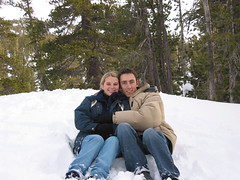Aztec ruins
This morning we had a slow start. We had planned on getting up early to head out to the ruins of Teotihuacán, but when that alarm went off, it just wasn´t going to happen. So we slept in a bit more, grabbed a yogurt and a coffee at 7-eleven on our way to the metro, and took 3 subway lines out to one of the city´s many bus stations. Oh the joys of being in a big city with an efficient public transportation network! Mexico City´s subway system is the world´s 3rd busiest system, after Moscow and Tokyo. And it is only US$0.20 a ride no matter how far you go! Bargain! It was very easy, quick, and organised. And also packed at that hour, so we had to be very careful not to spill our vanilla lattes on the nicely dressed locals on their way to work.
At the bus station, we bought a ticket out to the ruins and only waited about 5 minutes. It took one hour to get there. Teotihuacán is in a gorgeous setting, surrounded by the mountains of the Valle de México. It´s México´s biggest ancient city, was the capital of the country´s first and biggest ancient empire and civilisation. Between 250AD and 600AD, this Aztec city grew to over 125,000, and may have controlled the southern 2/3 of México in addition to all of Guatemala, Belize and bits of Honduras and El Salvador. Because of its greatness, this civilisation greatly influenced México´s later cultures.
Teotihuacán is most famous for its 2 huge Pirámides del Sol y de la Luna (Pyramids of the Sun and Moon). On first glimpse, we were not really impressed with these ruins. They seemed to be rather bland and boring. But as we walked around for over 3 hours, we discovered why this is such a magnificent site. Our first glimpse of this was at the Templo de Quetzalcóatl (one of their gods). This is a large complex surrounded by what used to be 15 pyramids but all that is left are the bases of the pyramids. The term ´pyramids´is a generic term because these are all actually step pyramids, so not truly pyramids by definition. Archaeologists started excavating the main temple and discovered the facade of an earlier structure from about 250-300AD. Because it had been buried all this time, magnificent carvings, paintings and sculptures remain intact. With this, we were given an idea of how spectacular the buildings once looked.
We followed the Calzada de los Muertos (Avenue of the Dead), which runs straight through the heart of the city, imagining what it may have looked like when all of the buildings, pyramids, hallways and plazas were complete. We were able to go underground some of the structures, seeing how the Aztecs built their chambers, rooms and passageways, then built over them a few times over the years to ´renovate.´ Some excellent paintings and carvings have been preserved due to their location underground. At the Palacio de los Jaguares (Jaguar Palace) and the Templo de los Caracoles Emplumados (Temple of the Plumed Conch Shells), we saw even more preserved paintings, carvings and sculptures. This is really the first place of ruins we were able to see how such cities may have looked in ancient times. We climbed the steep steps of both pyramids for fantastic views over the ruins and surrounding mountains.
It wasn´t too crowded, and had it not been for the many groups of schoolkids, there would hardly have been anyone there. After visiting the ruins, we spent some time in the excellent museum, which houses, among other things, many of the artifacts uncovered here. We just managed to catch a bus back to the city without having to wait, took the metro back to the centre, and grabbed some beer before heading back to the hotel and enjoying the cold beverages on the balcony of our room. Later we grabbed some dinner and walked around a bit before going to bed.


0 Comments:
Post a Comment
<< Home